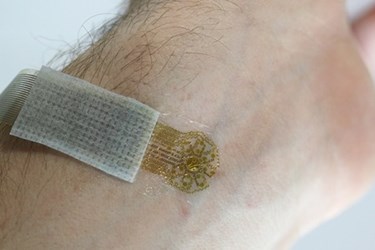Wearable Skin Patch Monitors Blood Flow 24/7

The latest advance in flexible electronics may make monitoring blood flow as simple as wearing a patch on the surface of the skin. The technology uses heat sensors to track temperature, information that is then converted by algorithm into an assessment of blood flow through veins, arteries, and capillaries. Scientists believe the device will provide doctors and researchers with a more accurate and convenient blood monitoring tool at a lower cost.
Changes in blood flow rates can be indicative of a number of different health problems. An increase in blood flow may be a sign of inflammation or infection, and a decrease might point to a developing problem, or complication of heart disease or diabetes. Most equipment used to monitor blood flow is bulky and requires a patient to lie still while a technician collects images, but researchers believe that capturing this information while a patient is active would give doctors a better idea of circulatory problems.
With this in mind, the Rogers Research Group — based at the University of Illinois at Urbana-Champaign and led by bioengineer John Rogers — developed an “epidermal electronic,” which can interpret heat signatures as indicators of blood flow beneath the skin. According to their findings, published in Science Advances, the patch can be worn comfortably by patients while they go about their daily routine, capturing information previously unavailable to doctors and researchers.
“Say you have diabetic patients and want to be able to monitor changes in specific blood vessels continuously for 24 hours a day,” said Chad Webb, lead author of the paper, to IEEE Spectrum. “There’s no way of doing that today.”
The patch is as ultrathin — 40 micrometers at its thickest — and works by heating up, and then tracking the direction and speed the heat travels away from the heat source by sensors arranged in concentric circles. Heat generated by the patch is below the threshold for human sensation, thus imperceptible to the wearer. According to the study, the patch is accurate to within .01 degrees Celsius.
By clinging to the skin using van der Waals forces, the patch does away with any relative motion interference between the device and the skin, which researchers said limited the accuracy of previous attempts at wearable blood flow monitors.
Rogers told MIT Technology Review that the researchers are currently using the patch to study wound healing and vascularization in skin grafts, and cosmetic company L’Oreal, which helped to fund the research, is using the device to study skin health.
Webb told IEEE Spectrum that the team plans to further develop the technology to make it smaller, more secure, and less dependent on outside power sources. He speculated that future applications could include attachments to surgical devices or patches that could be placed directly on organs. At this time, the system can only sense two millimeters beneath the skin, but future models, said Webb, will be capable of greater depths.
In August, the Pentagon invested $75 million in seed money for high-tech innovators developing flexible electronics, a commitment matched by a $96 million investment by local governments and the industry. A senior defense official told The Wall Street Journal, “We’re making the equivalent of a strategic bet on an important technology that we think could have broad applications in the future.”
